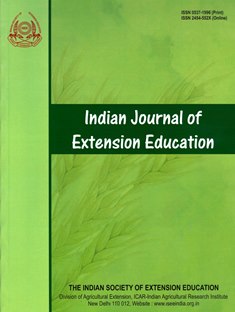Adoption Status of Rice Residue Management Technologies in South Western Punjab
Keywords:
Adoption, Happy seeder, Mulching and incorporation, Rice residue managementAbstract
The present study was conducted during 2019-20 in south-western Mansa district of Punjab. The study aimed to investigate the adoption status of different rice residue management (RRM) technologies. Data were collected from randomly selected 100 farmers, custom hiring centers (CHCs) and co-operative societies of the district. The total area under study was 5350±49.9 ha. Among the studied villages maximum area under RRM (404.0±12.6 ha) was in village Biro KeKalan of Budhlada block which constituted ~30 per cent of the total area under study. The least area under RRM (28.4±3.1 ha) was in village Kallhon of Mansa block which was only 4.6 per cent of the total area. The results of the study revealed that rice residue over about 43 per cent area was managed by farmers through different RRM technologies like mulching, incorporation and residue removal. The rice residue was either managed without burning or partial burning in case of very heavy straw load. Farmers preferred rice residue removal over other technologies of the total are managed, the area under rice residue removal was ~37 per cent which was accomplished by using either rectangular baler or manual labor. Area under residue mulching using happy seeder (HS) technology was ~31 per cent followed by rotavator (RT) (~14%) and super seeder (SS) technology (~7.7%). The manual removal of loose straw comprised only 2.3 per cent area. A number of constraints were faced by the farmers in RRM including yellowing of leaves, attack of pink stem borer, water stagnation and straw loading etc. The constraints reported by CHCs and co-operative societies in RRM were lack of high HP tractor among farmers and lack of skill to use new technology. Based on the results of the study it was concluded that there is significant increase in area under RRM, however, various constraints faced by farmers need to be addressed to further enhance area under RRM.
Downloads
Downloads
Published
Issue
Section
License

This work is licensed under a Creative Commons Attribution-NonCommercial-NoDerivatives 4.0 International License.

